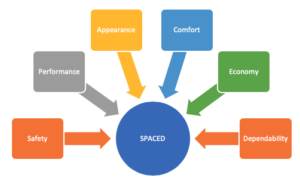Positioning: Who Are You For?
Guest blogger Alex Kraft discusses positioning in today’s blog, with the important question of who you are positioning yourself for? Who is your message meant to target? Are you a partner to your customers?
When you work for an established company, there are certain things that get taken for granted. Customers in the market know your brand and they’ve experienced your products. Opinions are formed based on experience. For young companies, the art of positioning becomes incredibly important.
Wikipedia defines ‘positioning’ as ‘the place that a brand occupies in the minds of the customers and how it is distinguished from the products of the competitors”. How do potential customers perceive your product when they haven’t experienced it and it’s not established? What I’ve learned over the past 18 months is: words matter. It’s remarkable how certain words trigger different responses and can create opportunities or worse, close doors in your face.
One of the major challenges with positioning is that everyone seems to use the same words, regardless of whether they are accurate or not. As I’ve written before on this site, Heave in its simplest form allows dealers/sales reps to quote contractors equipment (for rent or sale) easily on their mobile device. I’m very proud of what we’ve built so far and couldn’t wait to tell the industry….so terms like ‘platform’, ‘marketplace’, ‘e-commerce’, found their way into our positioning. The problem is that every tech company says that they are a platform/marketplace/e-commerce solution. The result is that you get drowned out amongst the crowd and no one remembers anything. Even worse, a customer will just assume your product is the same as one that they’ve maybe had a poor experience with, because of that similar description (without even trying it!).
For equipment dealers, it’s similar. Pick a dealer, any dealer. Don’t tell me who they are, let me guess: do they have the ’best’ or ‘quality equipment’, with ‘THE BEST SERVICE’? Are they ‘customer first’?
Are they a ‘partner’? I remember when I started as a Volvo salesman and attended a factory training session. Naturally I wanted to learn the areas where we had a competitive advantage, something tangible. One thing that I left armed with was Volvo’s superior fuel economy compared to the competition. Unfortunately for me, I was flipping through a Construction Equipment Guide the next week and I see ads for Case promising the ‘best fuel economy in the industry’, same as CAT, Deere, and Komatsu. Now Volvo is just another brand promising the same thing as everyone else. I had to go back to telling customers we just had the ‘best service’….
With Heave, we created something new and started with a blank slate. I became frustrated early on as we met people in the industry. ‘Why don’t they get it?’, I would ask one of my partners. It seemed so simple to me, but I lived it every waking moment. The more I read and researched other companies, the more I came to understand how important positioning is, and how it can set companies apart. I didn’t realize the skill involved in articulating an idea concisely with an economy of words. Once I had an appreciation for the nuance involved, we began tweaking our positioning. As we met with clients you could tell that it was resonating more, and we were getting closer. The final ‘aha’ moment for me was something that I believe every dealer/OEM can also learn from.
Positioning goes together with identifying a target market. A mistake that I know well is not recognizing your ideal customer. In the early days of Heave, I was afraid that if there were 100 potential customers, we needed to appeal to all 100. We couldn’t afford to have a smaller potential pool of customers I thought. Thankfully, I came across a sales trainer named Josh Braun. Josh’s content opened my eyes to how successful salespeople don’t try to sell or pitch to everyone; they focus their efforts on those who fit the solution. It finally clicked for me. Heave is not for the 15-20- year veteran salesperson who has the same 15 accounts for the past 10 years. Heave is for the younger, inexperienced, hungry sales reps who are new(er) to a territory and building their book of business. Have you ever noticed that those who say that “it’s a relationship business” are the ones who’ve had the relationships for 20 years? That saying is code for “this is MY customer, go find someone else!” This exercise was incredibly liberating for our team because it brought clarity to our mission and removed a ton of pressure. Now we weren’t wasting time talking to those who weren’t a good fit for our product. Do I believe that Heave could help that 15-year veteran salesperson? Of course, but why push a boulder uphill? Go talk to the 50,000 equipment salespeople in the US who are tired of cold calling offices and jobsites, that keep showing up and never get past the gatekeeper. Their manager offers solace by telling them, “Don’t worry, it’s just part of it. It took me 24 months to get my first crack at quoting Contracting. Now they buy 5 machines per year from us.” That is our ideal user and our positioning followed. Now we were speaking directly to them.
While equipment dealers aren’t starting with a blank slate, there is opportunity to stand out since everyone has been using the same terms since the 1960s. Don’t make the mistake of just copying the competition. You don’t have the same resources as the competition, and you don’t get credit for the ideas if you just are copying what someone else does. Who are the customers that your competition doesn’t serve? Maybe this fresh positioning could be tied to embracing the technology driven changes occurring in the industry? Maybe your positioning can be focused more on certain products or customer segments? On second thought, consistency is your friend, and you can’t go wrong with ‘We take customers to lunch, sign paper contracts, and we stock a lot of parts.”









